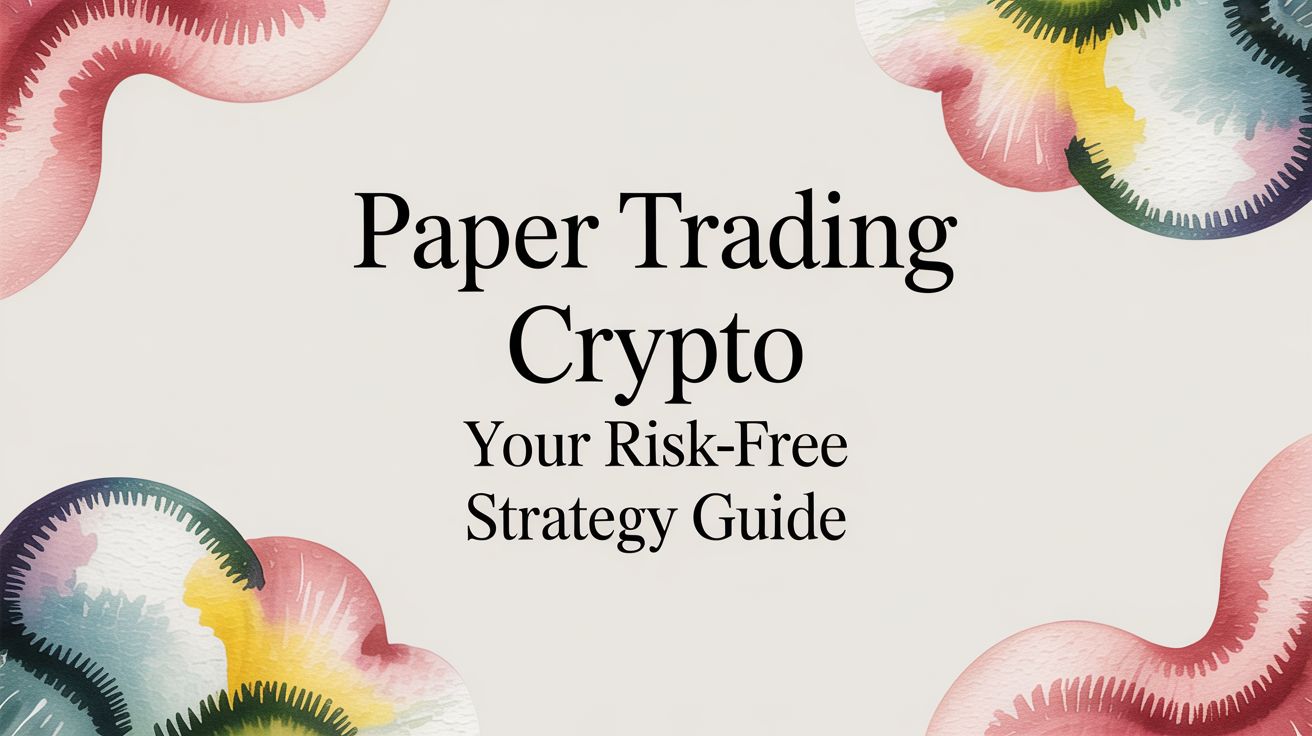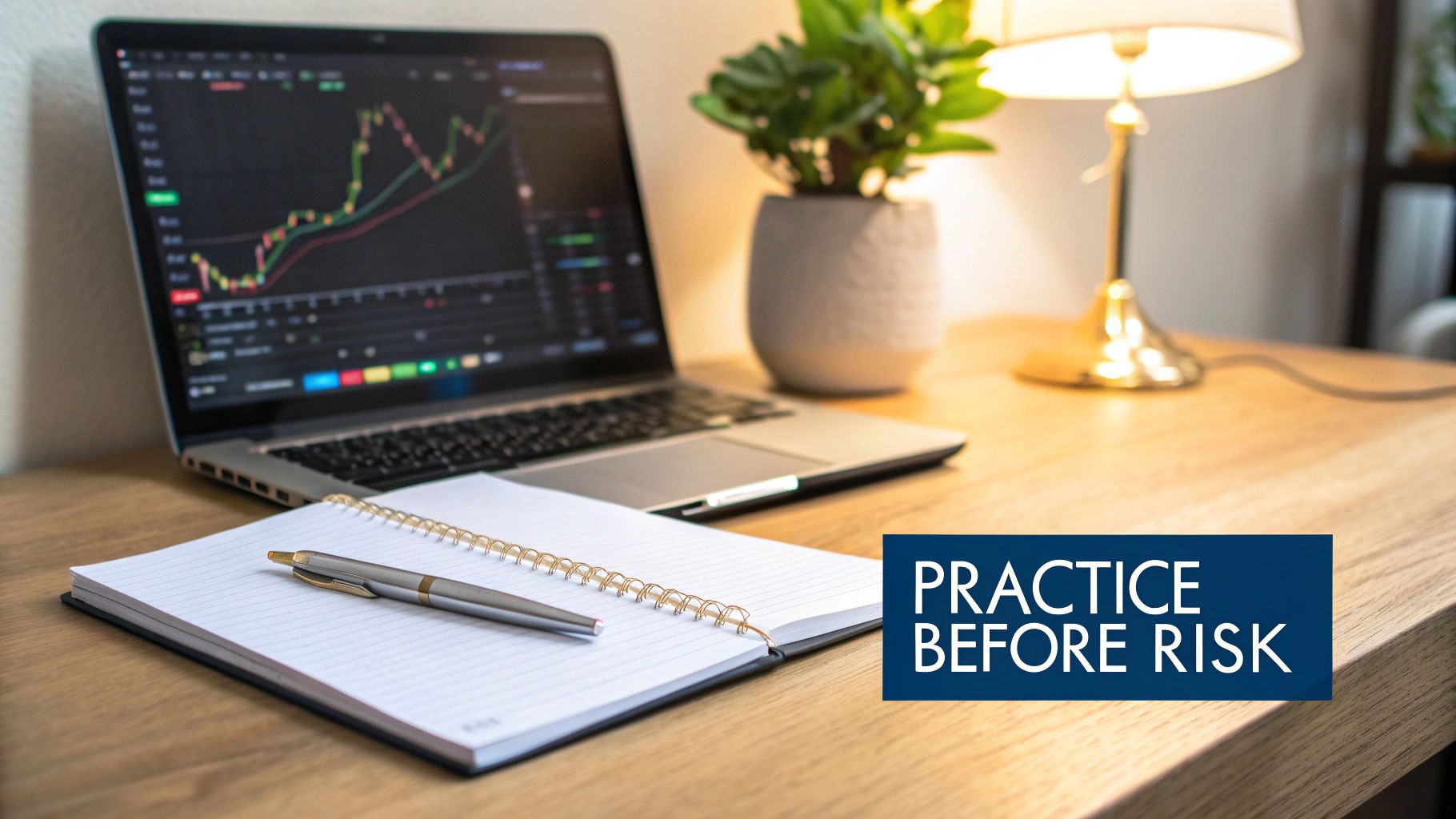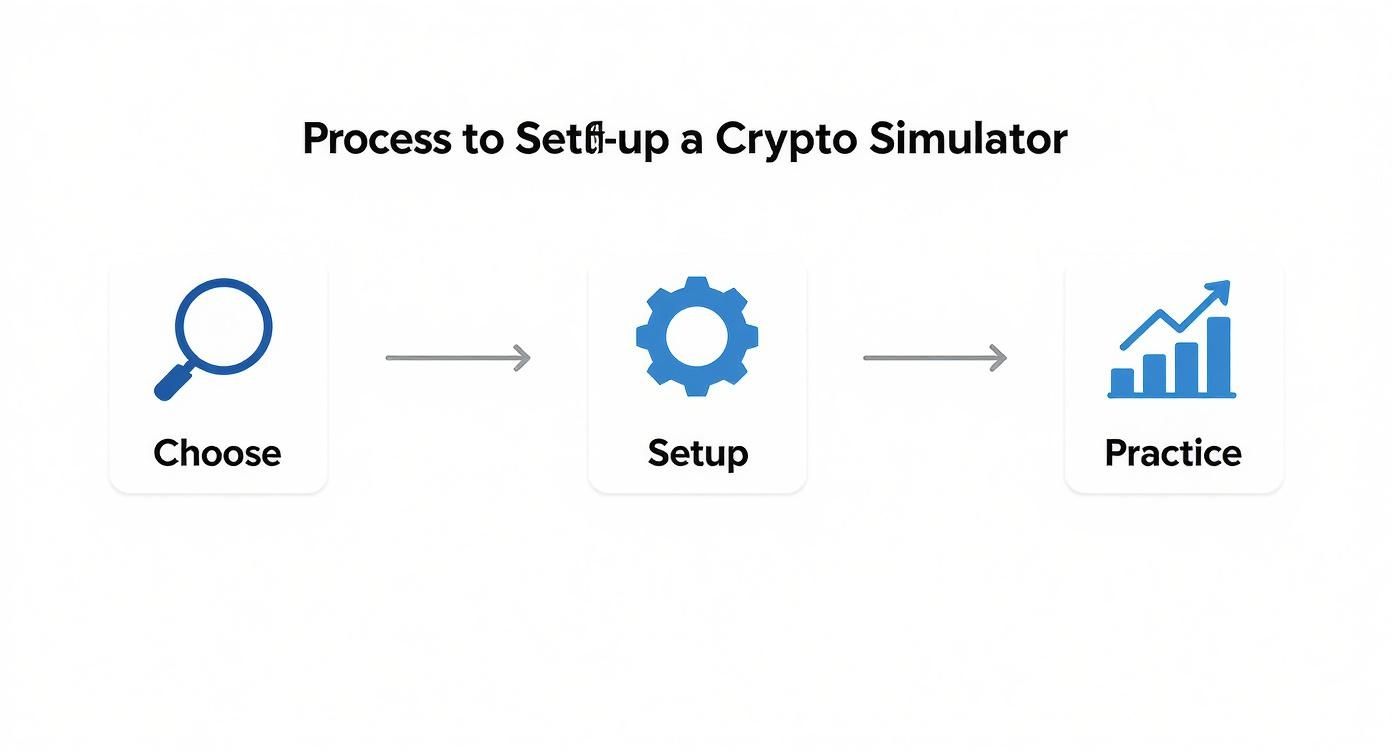CryptoMox Blog
Paper Trading Crypto Your Risk-Free Strategy Guide

Think of crypto paper trading as a full-dress rehearsal for the real thing. It's the practice of buying and selling digital assets, but in a completely simulated environment using virtual money. This lets you test strategies, learn the ropes of a trading platform, and build crucial discipline without putting a single dollar of your own capital on the line.
It’s an essential training ground for anyone serious about navigating the notoriously volatile crypto market.
Why Paper Trading Is Your Secret Weapon in Crypto

Jumping into the crypto market without a plan is a recipe for disaster. The wild price swings and the fact that it never sleeps can easily trigger emotional decisions and costly mistakes. This is exactly why paper trading crypto is such a game-changer.
Consider it your personal training gym—a professional simulator where you can build real confidence and skill away from the high-stakes pressure of live markets.
Master the Mechanics, Not Your Bank Account
Before you can nail a complex trading setup, you have to get the basics down cold. A simulator is the perfect place to practice placing different order types—market, limit, stop-loss—until you can do it in your sleep.
Actionable Example: Imagine you've identified a key support level for Bitcoin at $65,000. You don't want to buy at the current price, but you believe it's a good entry if it dips. In your paper trading account, you would set a limit order to buy 0.01 BTC precisely at $65,000. Simultaneously, you'd place a stop-loss order at $64,500 to automatically sell if the price breaks below your support. Practicing this sequence builds the muscle memory you need when a real trade is moving fast and every second counts.
Forge Real Emotional Discipline
The psychological battle is often the hardest part of trading. Fear and greed are powerful forces. Paper trading helps you build a strong defense by letting you follow your trading plan without the gut-wrenching anxiety of losing real money.
The key is to treat every simulated trade as if it were real. By doing that, you're training yourself to stick to your rules for entries, exits, and risk management. This discipline is what separates consistently profitable traders from the rest.
Actionable Example: Let's say your paper trading strategy signals a short on Ethereum, but a popular influencer on X (formerly Twitter) is posting bullish charts. The emotional urge is to ignore your strategy and follow the crowd. Your actionable insight here is to consciously take the trade your system generated, log the reason, and see it through. This trains you to trust your own analysis over market noise—a critical skill for real-world trading.
A Sandbox for Strategy Development
Paper trading is more than just a tool for beginners; it's a lab for traders at every level. It gives you a space to experiment with different approaches—like scalping or swing trading—using virtual funds that behave just like real ones. This lets you bypass the painful learning curve that causes so many new traders to lose money. In fact, studies from traditional markets show that over 70% of retail traders lose money, a figure that’s likely even higher in the crypto space. You can dig deeper into these challenges with these cryptocurrency statistics.
This simulated environment is perfect for:
- Testing technical indicators: See firsthand how a strategy based on the RSI or MACD performs across different coins and timeframes.
- Fine-tuning your risk: Experiment with different position sizes and stop-loss distances to find what truly matches your risk tolerance.
- Adapting to market phases: Practice your strategy during a bull run, a bear market, and a sideways grind to see where it shines and where it breaks.
Ultimately, paper trading isn't a crutch. It’s a professional tool for continuous learning and validating your edge in the market.
Choosing and Setting Up Your Crypto Simulator
Picking the right platform for paper trading is a lot like choosing your dojo. The training ground you select will shape the skills and habits you take into the real market. Your number one goal is to find a simulator that feels as close to the real thing as possible, so your practice translates perfectly when real money is on the line.
The first big question you need to answer is whether to use a simulator built into a major exchange or a dedicated charting and simulation platform. They both have their pros and cons, and the best choice really comes down to what you’re trying to accomplish.
Integrated Exchange Platforms vs. Dedicated Simulators
Exchange-based simulators, like the ones you’ll find on Binance or Bybit, are fantastic for getting comfortable with the exact environment where you'll eventually trade. You’ll learn the quirks of their order system, get a feel for the fee structure, and understand the platform’s unique tools in a completely safe space. It’s all about building muscle memory for that specific exchange.
On the other hand, dedicated platforms like TradingView often pack a bigger punch when it comes to charting tools, technical indicators, and community features. They’re built for serious strategy development and technical analysis, giving you a clean, focused environment without the constant temptation to just flip over to your live account.
What to Look for in a Great Simulator
As you’re weighing your options, keep an eye out for these must-have features. They’re what separate a useful training tool from a glorified video game.
- Live Data Feeds: This is non-negotiable. If the simulator doesn't use real-time market data, your practice is worthless. A strategy tested on delayed or inaccurate prices won’t hold up in the fast-moving crypto market.
- A Full Range of Order Types: At a bare minimum, you need to be able to practice with market, limit, and stop-loss orders. Mastering these is fundamental to managing risk.
- The Right Trading Pairs: Make sure the platform has the specific crypto pairs you actually want to trade, whether that’s BTC/USDT, SOL/USDT, or something more obscure.
- Solid Charting Tools: You'll need access to the essential drawing tools and technical indicators (like RSI, MACD, and moving averages) that form the backbone of your trading strategy.
Comparing Popular Crypto Paper Trading Platforms
With so many options out there, it can be tough to know where to start. Here's a look at some of the leading platforms to help you decide where you want to practice your crypto trading strategies.
| Platform | Best For | Real-Time Data | Key Features |
|---|---|---|---|
| TradingView | In-depth technical analysis and strategy backtesting. | Yes | Unmatched charting tools, massive library of community-built indicators, robust paper trading module. |
| Binance Futures | Traders who plan to trade futures on Binance. | Yes | Mirrors the live Binance Futures interface, includes advanced order types and leverage options. |
| Bybit Testnet | Practicing leveraged trading on the Bybit platform. | Yes | Realistic simulation of Bybit's derivatives exchange, including its fee and funding rate structure. |
| eToro | Beginners and those interested in social/copy trading. | Yes | User-friendly interface, virtual portfolio for practicing, ability to copy successful traders. |
Ultimately, the "best" platform is the one that aligns with your trading style and future plans. For pure strategy development, TradingView is hard to beat. If you know you'll be living on Binance, their simulator is the obvious choice to learn the ropes.
Setting Up Your Virtual Account for Success
Once you've picked your platform, the setup is your first real test of discipline. Don't just jump in and give yourself a fantasy portfolio.
Start by setting your virtual capital to a realistic amount—something that actually reflects what you plan to invest. If you’re going to start with $1,000, then set your paper trading account to $1,000. Practicing with a fictional $1,000,000 will only teach you bad habits and completely warp your sense of risk.
This hands-on, risk-free approach to learning is becoming a cornerstone of financial education. It's a powerful way to experiment with advanced strategies without the fear of financial loss, a concept you can see echoed across many platforms that are serious about user education. You can explore how leading platforms frame this by learning more about risk-free crypto skills on Coinrule.com.
Actionable Tip: Don't forget the fees! If your simulator allows it, set a realistic commission rate (like 0.1%) for your trades. This makes your profit and loss calculations far more accurate and gets you used to the real-world costs of trading from day one.
Alright, you've got your simulator picked out and your virtual cash is ready to go. Now for the fun part: building and breaking the trading strategies you'll eventually take into the real market. A simulator is just a tool; it's useless unless you have a clear, repeatable game plan to execute. This is where you graduate from just clicking buttons to practicing with purpose.
A real trading strategy isn't just a hunch. It's a strict rulebook that dictates every single move you make. It tells you what to trade, exactly when to get in, where to cash out, and—most importantly—when to admit you were wrong and cut a loss. Your mission is to build a playbook for different market moods and timeframes, whether you're scalping quick intraday moves or riding bigger, multi-day swings.
This is the basic flow to get your practice environment rolling.

As you can see, practice isn't an afterthought. It's the entire point once you're set up.
Designing an Intraday Trading Workflow
Intraday trading is all about speed. You're in and out of positions within the same day, hunting for quick profits on lower timeframes like the 5-minute or 15-minute charts. Most of these strategies are built on the back of technical indicators that signal shifts in momentum.
Let's walk through a concrete example of a simple strategy around the classic combo of the Relative Strength Index (RSI) and the Moving Average Convergence Divergence (MACD). Your rules need to be crystal clear.
- The Setup: You're looking to go long on ETH/USDT on the 15-minute chart.
- Your Entry Signal: You will only enter a trade when two conditions are met:
- The 15-minute MACD line crosses above its signal line.
- The RSI is below 50 and is clearly pointing up.
- Your Exit Plan:
- Take-Profit: Place an order to sell 1.5% above your entry price.
- Stop-Loss: Place an order to sell 0.75% below your entry price.
- The Result: This locks in a clean 2:1 reward-to-risk ratio on every trade.
See how specific that is? There's no room for emotion or second-guessing. If you want to dive deeper into how these two indicators work together, our guide on the MACD and RSI indicators is a great place to start. A system like this forces you to trade your plan, not your feelings.
Building a Swing Trading Strategy
Swing trading is a different beast entirely. Here, you’re operating on higher timeframes—think the 4-hour or daily chart—and your goal is to capture a single, chunky price swing over several days or even weeks. These strategies often care less about indicator crossovers and more about major market structure, like classic support and resistance zones.
Imagine you're stalking a swing trade on SOL/USDT. Your entire workflow would revolve around how price behaves at key historical levels.
A swing trader's mindset is all about patience. You're not chasing every little wiggle on the chart. You're identifying major zones where buyers and sellers have battled before, and you're waiting for the perfect moment to join the winning side.
Here’s a practical, actionable example of a swing trading plan:
- Identify Your Zone: You pull up the 4-hour chart for Solana and notice that price has bounced hard off the $140 support level multiple times. That $140 area is now your hunting ground.
- Define Your Trigger: You don't just blindly buy at $140. Your rule is to wait for a clear bullish candlestick pattern—like a hammer or a bullish engulfing candle—to form right on that support level. This is your confirmation that buyers are actually showing up.
- Set Your Orders: As soon as that trigger candle closes, you enter your long position. For instance, if the bullish candle closed at $142 and its low was $139, your orders would be:
- Entry: Buy at the market price of $142.
- Stop-Loss: Place it just below the candle's low, at $138.50.
- Profit Target: Place it just below the next major resistance area, which appears to be around $165. Your target would be $164.
By defining these objective rules before you even think about clicking "buy," you build a disciplined framework. This is the heart of effective paper trading crypto—turning a theory into a concrete plan that you can test, measure, and improve over dozens or hundreds of simulated trades.
Analyzing Your Performance Like a Professional Trader

Running trades in a simulator is really only half the job. The real growth happens when you start treating your paper trading sessions like a business. That means you need to meticulously track and analyze every single move you make. Gut feelings can fool you, but hard data always tells the truth about what’s working and what’s not.
This is where a detailed trading journal becomes your most powerful tool. It’s far more than a simple log of wins and losses. A proper journal forces you to document the "why" behind each trade, building a rich dataset you can mine for insights to sharpen your edge.
Building Your Trading Journal
Don't overthink it—your journal doesn't need to be complex. A simple spreadsheet is more than enough to get started capturing the data that truly matters. For every simulated trade, you should be recording not just the entry and exit prices but the entire context that shaped your decision.
Here is an example of what a journal entry might look like:
- Asset: SOL/USDT
- Strategy Used: 4H Support Bounce
- Timeframe: 4-hour
- Entry/Exit/Stop-Loss: Entry: $142, Exit: $164 (Target Hit), Stop-Loss: $138.50
- Position Size: $100 (1% of $10k account)
- Reason for Entry: "Price hit major 4H support at $140 and formed a clear bullish engulfing candle. Confirmation was solid."
- Emotional State: "Felt patient and confident in the setup. Stuck to the plan."
This level of detail transforms your trading history into an invaluable feedback loop. It helps you draw a direct line between your mindset, your strategy execution, and your results. If you're still getting the hang of chart analysis, our guide on how to read crypto charts is a great place to build a stronger foundation.
Calculating Your Key Performance Metrics
Once you’ve logged a few dozen trades in your journal, you can start crunching the numbers that professional traders live and die by. These metrics cut through the noise and give you an objective, unfiltered look at your performance.
The goal isn't just to be profitable; it's to understand why you're profitable. Key metrics reveal the true health of your strategy, exposing hidden weaknesses even when you're on a winning streak.
To get started, you’ll want to track these essential metrics to objectively measure your trading performance and find areas for improvement.
Key Metrics for Your Paper Trading Journal
| Metric | What It Measures | How to Calculate It | Why It Matters |
|---|---|---|---|
| Win Rate | The percentage of trades that end up profitable. | (Number of Winning Trades / Total Trades) x 100 | Shows how often your strategy is right, but must be viewed alongside your risk-to-reward ratio. |
| Expectancy | The average amount you expect to win or lose per trade. | (Win Rate x Avg. Win) - (Loss Rate x Avg. Loss) | This is your statistical edge. A positive expectancy means your strategy is profitable over time. |
| Max Drawdown | The largest peak-to-trough decline in your account's value. | (Peak Value - Trough Value) / Peak Value | Measures the worst losing streak, telling you if you can stomach the strategy's volatility. |
These metrics work together to paint a complete picture. For example, you might discover you have a 45% win rate, which sounds mediocre on its own. But if your average winner is three times bigger than your average loser (a 3:1 risk-to-reward ratio), your strategy is actually highly profitable.
Focusing on these numbers helps you refine your approach based on solid evidence, not emotion. They tell you what's real, what needs fixing, and whether you truly have an edge in the markets.
From Practice to Performance: How to Refine Your Approach
Alright, you've been disciplined. You've got a trading journal filled with data, and that's a huge step. This is where the real work begins—and where most aspiring traders drop the ball.
Now, we shift from just practicing to actively improving. You're about to turn that raw data from your paper trading sessions into a smarter, sharper trading plan.
Correcting Common Behavioral Errors
The first place to hunt for improvements? Your losses. Seriously. Go through your journal and look for the painful trades, the ones that went wrong. You're not just looking at what happened, but why it happened.
Actionable Example: You review your journal and notice a pattern: 5 of your last 7 losing trades have a note like "Revenge traded after a small loss" or "Felt FOMO and jumped in late." The data is telling you that your emotions, not your strategy, are the problem.
Actionable Tip: Once you spot a bad habit like this, create a "circuit breaker" rule. For instance: "After any two consecutive losing trades, I must close my trading platform and walk away for at least one hour. No exceptions." This forces a mental reset and prevents emotional decisions.
Fine-Tuning Your Strategy Rules
Once you’ve started patching up the psychological holes, it’s time to look at the mechanics of your strategy itself. Your performance data is the ultimate truth-teller here.
Maybe your journal clearly shows that your intraday RSI strategy absolutely crushes it during the London and New York session overlap but gets chewed up and spit out during the quiet Asian session. That's not a failed strategy; that's a crucial piece of intel.
This is where you can make small, data-backed tweaks that have a huge impact.
- Adjusting Position Sizing: Let's say trades with high CryptoMox confidence scores and clean technical confluence have a much higher win rate in your journal. You could decide to risk 1.5% on these A+ setups, while only risking 0.75% on more standard B-grade trades.
- Tweaking Profit Targets: Is your data screaming that your 3:1 reward-to-risk target is just a bit too ambitious? If you see price constantly reversing just shy of your target, test a more conservative 2.5:1 R:R. Hitting more winners, even if they're slightly smaller, can dramatically improve your overall expectancy.
- Filtering for Market Conditions: You might discover your long setups fail miserably when the overall market is bleeding. So, you add a simple filter: only take long trades if the price is holding above the 200-period moving average on the 4-hour chart. This one rule can keep you from fighting the dominant trend.
Making these kinds of systematic changes is how you build a robust trading system. For a deeper dive into creating and automating rule-based systems, our guide on algorithmic trading strategies is a great resource. The core principles are exactly the same, whether a human or a bot is pulling the trigger.
This whole process is about creating a feedback loop: you trade, you record, you analyze, you refine. You do it again and again. This is what turns a generic plan into a battle-tested strategy that fits you perfectly, sharpened by experience and proven by your own data.
Common Questions About Crypto Paper Trading
When you first dip your toes into paper trading crypto, a bunch of questions usually pop up. Getting good answers from the get-go helps you set up your practice sessions the right way and build habits that will actually serve you when real money is on the line.
Let's walk through some of the most common things traders ask when they’re starting out in a simulator.
Is Paper Trading Exactly Like the Real Thing?
Not even close, and that's a critical distinction to make. Paper trading is fantastic for nailing the mechanics—getting comfortable with a platform, practicing how to place different order types, and seeing if a strategy’s rules hold up against real-time data. It's how you build muscle memory.
Where it falls short is the psychological side of the game. When you're trading with fake money, the gut-wrenching fear of loss and the giddy greed of a hot streak are completely absent. In the live market, those emotions are powerful forces that can hijack your decision-making.
Think of it like a flight simulator. A pilot can master every button and emergency checklist on the ground, but nothing truly prepares them for the adrenaline spike of a real-world engine failure at 30,000 feet. Paper trading is your ground school—absolutely essential, but still just training.
How Long Should I Paper Trade Before Using Real Money?
There’s no set time frame. Instead of watching the calendar, watch your results. A good rule of thumb is to aim for at least 50-100 trades following one specific, clearly defined strategy.
What you're looking for is consistency. You need enough data to prove your strategy has a positive expectancy. Once you can execute your plan flawlessly without emotional slip-ups, and your trading journal shows you're consistently profitable over a solid number of trades, you might be ready.
But don't jump into the deep end. The next step is to start trading with a tiny amount of real capital—an amount you would be perfectly fine with losing. This is how you slowly introduce the psychological stress of having actual skin in the game.
What Are the Biggest Mistakes People Make When Paper Trading?
The single biggest blunder is not taking it seriously. Treating it like a video game is the fastest way to learn absolutely nothing and build destructive habits.
Here are the top pitfalls I see traders fall into:
- "Monopoly Money" Mindset: Practicing with a $1,000,000 account is useless. It teaches you nothing about proper risk and position sizing. Use an account size that mirrors what you'll actually fund your live account with.
- Bending the Rules: It's so easy to ignore your stop-loss or take a wild flyer on a trade "just to see what happens." After all, it's not real money. But this behavior trains you to be an undisciplined trader.
- Skipping the Journal: If you aren't logging every trade, you have zero ability to review your performance, find your weaknesses, and make objective improvements. You're just gambling without feedback.
To make your paper trading crypto sessions count, you have to treat every single click as if your own hard-earned cash were at risk. That's the discipline that forges a real trader.
Ready to move beyond lagging indicators and trade with a forward-looking edge? CryptoMox provides AI-powered price projections and confidence scores to help you build and test your trading plan with clarity. See the future of your strategy.